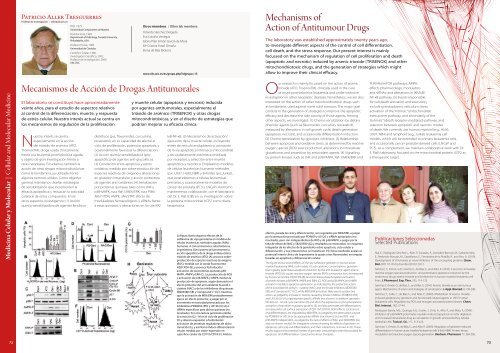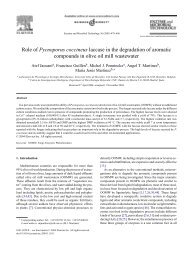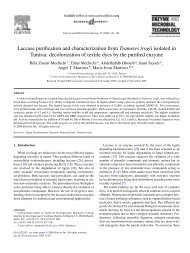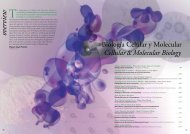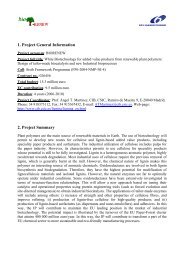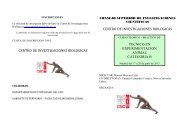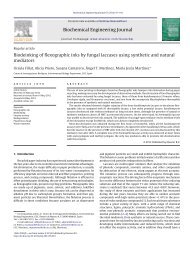03 Medicina Celular y Molecular.pdf 5474KB May - Centro de ...
03 Medicina Celular y Molecular.pdf 5474KB May - Centro de ...
03 Medicina Celular y Molecular.pdf 5474KB May - Centro de ...
You also want an ePaper? Increase the reach of your titles
YUMPU automatically turns print PDFs into web optimized ePapers that Google loves.
<strong>Medicina</strong> <strong>Celular</strong> y <strong>Molecular</strong> | Cellular and <strong>Molecular</strong> Medicine<br />
72<br />
Patricio aller Tresguerres<br />
Profesor <strong>de</strong> Investigación | aller@cib.csic.es<br />
Mecanismos <strong>de</strong> Acción <strong>de</strong> Drogas Antitumorales<br />
Nuestro interés se centra<br />
especialmente en la acción<br />
<strong>de</strong>l trióxido <strong>de</strong> arsénico (ATO,<br />
TrisenoxTM), droga usada clínicamente<br />
frente a la leucemia promielocítica aguda,<br />
y objeto <strong>de</strong> gran investigación frente a<br />
otras neoplasias. Estudiamos también la<br />
acción <strong>de</strong> otras drogas mitocondriotóxicas<br />
como la lonidamina, ya utilizada frente<br />
algunos tumores sólidos. Como objetivo<br />
general, intentamos diseñar estrategias<br />
<strong>de</strong> sensibilización que incrementen la<br />
eficacia apoptótica y reduzcan la toxicidad<br />
colateral <strong>de</strong> estos compuestos. Entre<br />
otros aspectos, investigamos: (1) Acción<br />
quimio-sensibilizadora <strong>de</strong> agentes fenólicos<br />
PhD, 1979.<br />
Universidad Complutense <strong>de</strong> Madrid.<br />
Postdoctoral, 1983.<br />
Department of Pathology, Temple University,<br />
Phila<strong>de</strong>lphia, USA.<br />
Profesor Titular, 1985.<br />
Universidad <strong>de</strong> Córdoba.<br />
Científico Titular, 1986,<br />
Investigador Científico, 2002,<br />
Profesor <strong>de</strong> Investigación, 2009.<br />
CIB, CSIC.<br />
El laboratorio se constituyó hace aproximadamente<br />
veinte años, para el estudio <strong>de</strong> aspectos relativos<br />
al control <strong>de</strong> la diferenciación, muerte, y respuesta<br />
<strong>de</strong> estrés celular. Nuestro interés actual se centra en<br />
los mecanismos <strong>de</strong> regulación <strong>de</strong> la proliferación<br />
dietéticos (p.e., flavonoi<strong>de</strong>s, curcumina,<br />
resveratrol), en su capacidad <strong>de</strong> afectar el<br />
ciclo <strong>de</strong> proliferación, potenciar apoptosis, y<br />
ocasionalmente favorecer la diferenciación.<br />
(2) Acción quimio-sensibilizadora (proapoptótica)<br />
<strong>de</strong> agentes anti-glucolíticos.<br />
(3) Correlación entre apoptosis y estrés<br />
oxidativo, medido por sobre-producción <strong>de</strong><br />
especies reactivas <strong>de</strong> oxígeno y alteraciones<br />
en glutation intracelular, y acción protectora<br />
<strong>de</strong> agentes anti-oxidantes. (4) Señalización<br />
por proteínas quinasas tales como JNK y<br />
p38-MAPK, ruta Raf-1/MEK/ERK, ruta PI3K/<br />
Akt/mTOR, AMPK, JAK/STAT; efecto <strong>de</strong><br />
moduladores farmacológicos y siRNAs frente<br />
a estas quinasas; y alteraciones en la ruta IKK/<br />
Otros miembros | Other lab members:<br />
Yolanda Sánchez Delgado<br />
Eva Calviño Venegas<br />
Gloria Pilar Simón García <strong>de</strong> Mora<br />
Mª Cristina Estañ Omaña<br />
Elena <strong>de</strong> Blas Brotons<br />
www.cib.csic.es/es/grupo.php?idgrupo=13<br />
y muerte celular (apoptosis y necrosis) inducida<br />
por agentes antitumorales, especialmente el<br />
trióxido <strong>de</strong> arsénico (TRISENOX) y otras drogas<br />
mitocondriotóxicas, y en el diseño <strong>de</strong> estrategias que<br />
podrían mejorar su eficacia clínica.<br />
IκB-NF-κB. (5) Mecanismos <strong>de</strong> activación/<br />
ejecución <strong>de</strong> la muerte celular, incluyendo<br />
estrés <strong>de</strong> retículo endoplásmico, activación<br />
<strong>de</strong> la vía apoptótica intrínseca (mitocondrial)<br />
y secundariamente extrínseca (mediada<br />
por receptor), y selección entre muerte<br />
apoptótica y necrótica. Empleamos mo<strong>de</strong>los<br />
<strong>de</strong> células leucémicas humanas mieloi<strong>de</strong>s<br />
(p.e. U937, HL60, NB4) y linfoi<strong>de</strong>s (p.e.,Jurkat),<br />
que exten<strong>de</strong>remos a células leucemicas<br />
primarias, y ocasionalmente mo<strong>de</strong>los <strong>de</strong><br />
cáncer <strong>de</strong> próstata (PC3 y LNCaP). Asimismo<br />
mantenemos colaboración con el laboratorio<br />
<strong>de</strong>l Dr. E. Rial (CIB), en su investigación sobre<br />
la proteína mitocondrial UCP2 como diana<br />
terapéutica.<br />
La figura ilustra algunos efectos <strong>de</strong> la<br />
isoflavona <strong>de</strong> soja genisteína en mo<strong>de</strong>los <strong>de</strong><br />
células leucémicas mieloi<strong>de</strong>s agudas (AML)<br />
humanas. A concentraciones subcitotóxicas,<br />
la genisteína (Gen) potencia fuertemente la<br />
acción apoptótica <strong>de</strong> la droga antileucémica<br />
trióxido <strong>de</strong> arsénico (ATO) (A); provoca sobreproducción<br />
<strong>de</strong> especies reactivas <strong>de</strong> oxigeno<br />
(ROS), medida con la sonda fluorescente<br />
H2DCFDA (B), y provoca fosforilación/<br />
activación <strong>de</strong> las proteínas quinasas p38-<br />
MAPK, AMPK y ERK (C). La producción <strong>de</strong> ROS<br />
y activación <strong>de</strong> p38-MAPK y AMPK median la<br />
producción <strong>de</strong> apoptosis, según <strong>de</strong>muestra el<br />
efecto protector <strong>de</strong>l anti-oxidante N-acetil-Lcisteína<br />
(NAC) y <strong>de</strong> los inhibidores <strong>de</strong> quinasas<br />
SB2<strong>03</strong>580 (SB) y “compound C” (CC), mientras<br />
que la activación <strong>de</strong> MEK/ERK probablemente<br />
ejerce un efecto protector, a juzgar por el<br />
incremento en toxicidad provocado por los<br />
inhibidores PD98059 (PD) y U0126 (U) (A) o<br />
siRNAs específicos para dichas quinasas (no<br />
mostrado). Por otro lado la genisteína inhibe<br />
la transición G2 – M en el ciclo <strong>de</strong> proliferación<br />
(D) y altera la expresión o fosforilación/<br />
activación <strong>de</strong> proteínas reguladoras <strong>de</strong> dicha<br />
transición (E), y asimismo induce diferenciación<br />
celular, medida por sobre-expresión en<br />
superficie celular <strong>de</strong> CD11b/CD18 (F). Ambos<br />
Mechanisms of<br />
Action of Antitumour Drugs<br />
The laboratory was established approximately twenty years ago,<br />
to investigate different aspects of the control of cell differentiation,<br />
cell <strong>de</strong>ath, and the stress response. Our present interest is mainly<br />
focussed on the mechanism of regulation of cell proliferation and <strong>de</strong>ath<br />
(apoptotic and necrotic) induced by arsenic trioxi<strong>de</strong> (TRISENOX) and other<br />
mitochondriotoxic drugs, and the generation of strategies which might<br />
allow to improve their clinical efficacy.<br />
Our research is mainly focussed on the action of arsenic<br />
trioxi<strong>de</strong> (ATO, TrisenoxTM), clinically used in the cure<br />
of acute promielocítica leukaemia and un<strong>de</strong>r intensive<br />
investigation in other neoplastic diseases. Nonetheless, we are also<br />
interested on the action of other mitochondriotoxic drugs such<br />
as lonidamine, used against some solid tumours. The major goal<br />
consists in the generation of strategies to improve the apoptotic<br />
efficacy and <strong>de</strong>crease the si<strong>de</strong> toxicity of those agents. Among<br />
other aspects, we investigate: (1) Chemo-sensitization by dietary<br />
phenolic agents (such as flavonoi<strong>de</strong>s, curcumin, resveratrol),<br />
measured by alterations in cell growth cycle, <strong>de</strong>ath generation<br />
(apoptosis, necrosis), and occasionally differentiation induction.<br />
(2) Chemo-sensitization by glycolytic inhibitors. (3) Relationship<br />
between apoptosis and oxidative stress, as <strong>de</strong>termined by reactive<br />
oxygen species (ROS) over-production, alterations in intracellular<br />
glutathione, and protection by antioxidant agents. (4) Signalling<br />
by protein kinases such as JNK and p38-MAPK, Raf-1/MEK/ERK and<br />
efectos, parada <strong>de</strong> ciclo y diferenciación, son regulados por MEK/ERK, a juzgar<br />
por la atenuación provocada por PD9859 y U0126 o siRNAs apropiados (no<br />
mostrado), pero son in<strong>de</strong>pendientes <strong>de</strong> ROS y <strong>de</strong> p38-MAPK, a juzgar por la<br />
falta <strong>de</strong> efecto <strong>de</strong> NAC y SB2<strong>03</strong>580 ((G) y resultados no mostrados). Un esquema<br />
integrador <strong>de</strong> los efectos <strong>de</strong> la genisteína sobre apoptosis, ciclo celular y<br />
diferenciación, y sus interacciones, se muestra en (H). Estos resultados avalan el<br />
potencial interés clínico <strong>de</strong> la genisteína (y quizás otros flavonoi<strong>de</strong>s) en terapias<br />
basadas en apoptosis y diferenciación celular.<br />
The figure shows several effects of the soy isoflavone genistein in human acute<br />
myeloid leukaemia (AML) cell mo<strong>de</strong>ls. At sub-cytotoxic concentrations, genistein<br />
(Gen) greatly potentiates apoptosis induction by the anti-leukaemic agent arsenic<br />
trioxi<strong>de</strong> (ATO) (A); causes reactive oxygen species (ROS) over-production, as measured<br />
by fluorescent probe H2DCFDA (B), and stimulates phosphorylation/activation<br />
of protein kinases p38-MAPK, AMPK and ERKs (C). ROS and p38-MAPK and AMPK<br />
activation mediates apoptosis generation, as indicated by the protective action<br />
of the antioxidant N-acetyl-L- cysteine (NAC) and the kinase inhibitors SB2<strong>03</strong>580<br />
(SB) and “compound C” (CC), while MEK/ERK activation likely exerts a protective<br />
action, as judged by increase in toxicity caused by kinase inhibitors PD98059 (PD)<br />
and U0126 (U) (A) or appropriate specific siRNAs (not shown). In addition, genistein<br />
inhibits G2 – M cell cycle transition (D) and alters the expression or phosphorylation/<br />
activation of transition regulatory proteins (E), and also promotes cell differentiation,<br />
as measured y cell surface expression of CD11b/CD18 (F). Both effects, cycle arrest<br />
and differentiation, are regulated by MEK/ERK, as judged by the attenuation caused<br />
by PD98059 or U0126 or by appropriate siRNAs (not shown), but are ROS- and<br />
p38-MAPK-in<strong>de</strong>pen<strong>de</strong>nt, as judged by the lack of effects of NAC and SB2<strong>03</strong>580 ((G)<br />
and not-shown results). An integrative scheme showing the effects of genistein on<br />
apoptosis, cell cycle and differentiation, and their interactions, is shown in (H). These<br />
results support the potential interest of genistein (and perhaps other flavonoi<strong>de</strong>s) for<br />
apoptosis- and differentiation- based anti-tumour therapies.<br />
PI3K/Akt/mTOR pathways, AMPK;<br />
effects pharmacologic modulators<br />
and siRNAs; and alterations in IKK/IκB/<br />
NF-κB pathway. (5) Events responsible<br />
for cell <strong>de</strong>ath activation and execution,<br />
including endoplasmic reticulum stress,<br />
activation of the “intrinsic” (mitochondrial)<br />
executioner pathway, and secondarily of the<br />
“extrinsic” (<strong>de</strong>ath receptor-mediated) pathway, and<br />
selection between apoptotic and necrotic mo<strong>de</strong>s<br />
of <strong>de</strong>ath. We currently use human myeloid (e.g., HL60,<br />
U937, NB4) and lymphoid (e.g., Jurkat) leukaemia cell<br />
mo<strong>de</strong>ls, which will be exten<strong>de</strong>d to primary leukaemia cells,<br />
and occasionally cancer prostate-<strong>de</strong>rived cells (LNCaP and<br />
PC3). As a complement, we maintain collaborative work with Dr.<br />
E. Rial’s laboratory, focused on the mitochondrial protein UCP2 as<br />
a therapeutic target.<br />
Publicaciones Seleccionadas<br />
Selected Publications<br />
Rial, E., Rodríguez-Sánchez L., Aller, P., Guisado, A., González-Barroso, M., Gallardo-Vara,<br />
E., Redondo-Horcajo, M., Castellanos, E., Fernán<strong>de</strong>z <strong>de</strong> la Pradilla, R., and Viso, A. (2010).<br />
Development of chromanes as novel inhibitors of the uncoupling proteins. Chem.<br />
Biol. DOI: 10.1016/j.chembiol.2010.12.012.<br />
Sánchez, Y., Simón, G.P., Calviño, E., <strong>de</strong> Blas, E., and Aller, P., (2010). Curcumin stimulates<br />
reactive oxygen species production and potentiates apoptosis induction by the<br />
antitumour drugs arsenic trioxi<strong>de</strong> and lonidamine in human myeloid leukaemia cell<br />
lines. J. Pharmacol. Exp. Ther. 335, 114-123.<br />
Sánchez Y, Amrán D., <strong>de</strong> Blas, E., and Aller, P., (2010). Arsenic trioxi<strong>de</strong> as an anti-tumour<br />
agent. Mechanisms of action and strategies of sensitization. J. Appl. Biomed. 8, 199-208.<br />
Sánchez, Y., Calle, C., <strong>de</strong> Blas, E., and Aller, P., (2009). Modulation of arsenic trioxi<strong>de</strong>induced<br />
apoptosis by genistein and functionally related agents in U937 human<br />
leukaemia cells. Regulation by ROS and mitogen-activated protein kinases. Chem.<br />
Biol. Interact. 182, 37-44.<br />
Rodríguez-García, M.E., Quiroga, A.G., Castro, J., Ortiz, A., Aller, P., and Mata, F., (2009).<br />
Inhibition of p38-MAPK potentiates cisplatin-induced apoptosis via GSH <strong>de</strong>pletion<br />
and increased intracellular drug accumulation in growth-arrested kidney tubular<br />
epithelial cells. Toxicol. Sci. 111, 413-423,<br />
Sánchez, Y., Amrán, D., <strong>de</strong> Blas, E., and Aller, P., (2009). Regulation of genistein-induced<br />
differentiation in human acute myeloid leukaemia cells (HL60, NB4). Protein kinase<br />
modulation and reactive oxygen species generation. Biochem. Pharmacol. 77, 384-396.<br />
73


